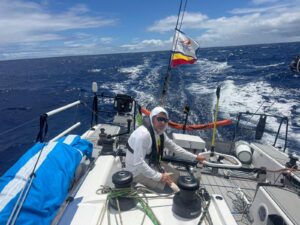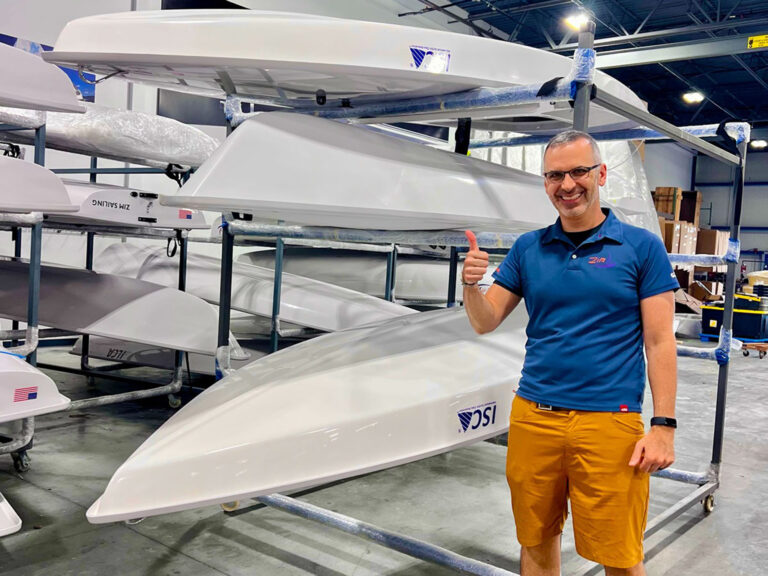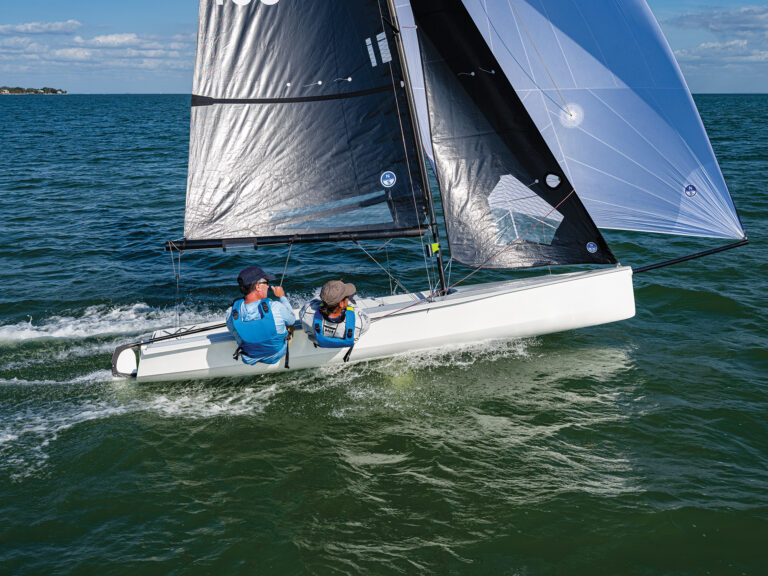This article was originally featured in Sailing World May 2000.
Remember the images of the super flat jibs and mainsails draped on a composite array of carbon fibers? Or Luna Rossa straitjacketed in the remnants of its indestructible chute? That was sail development, Americas Cup style–far away on the Hauraki Gulf, but destined to become meaningful to club sailors in time.
Carbon sails have been used in the Cup since 1992, but are still illegal in IMS racing and remain too pricey for most applications. Their life span is “probably 75 to 100 tacks or 10 hours, whichever comes first,” says Moose McClintock, trimmer on AmericaOne and sales rep at Contender US Sailcloth.
Why not use a material less susceptible to fatigue when it flexes? Burns Fallow, Team New Zealand’s North Sails designer says, “Carbon is the lowest-stretch material for a given weight. It’s a little fragile, but surprisingly not so fragile as we may have thought.”
During Americas Cup 2000, hybrid carbon/aramid sails predominated in jibs and mains, as nearly all of the syndicates worked with North Sails to make carbon/aramid 3DLs. Kevlar is the best known of the aramid fibers (or linear polymers). Twaron and Technora are also aramids. PBO was used by only a few syndicates–notably John Koliuss Abracadabra group, which had carbon/PBO sails made by Quantum.
“We find carbons both stronger and more durable than PBO,” says Robert Hook, AmericaOne sail designer. “North makes 3DL sails with PBO for grand prix racing, but mainly because carbons illegal.”
Larry Leonard, president of Quantum Sails, says that PBO and the better carbons have similar resistance to stretch. Carbon, he says, is brittle and breaks down when overflexed, but PBO loses strength with exposure to light–something PBO supplier Dimension Polyant counters with its MagnaShield film.
Regarding the low-budget Abracadabra program, Leonard says the sails werent replaced as often as needed, but that he was pleased with the sail development Quantum achieved. “The principal component in our sails was carbon,” he says. “We used PBO as a safety net, much like North used Twaron.” Leonard says that legalizing carbon is “the right thing to do for the customer,” and that his company plans to introduce carbon for some top PHRF programs.
Despite its prohibition under IMS, carbon is already making headway aboard Sleds and in other high-end racing where its legal. After this Cup campaign, it will likely show up more frequently, and not only in North 3DL sails.
“Ideally, carbon is used as a pure, untwisted, woven fiber, inserted into a laminated composite fabric,” says Rich McGhee, vice president of Dimension Polyant Sailcloth. “Weve been utilizing carbon fiber in sailcloth for over seven years in combination with Spectra, Kevlar, and PBO Zylon.”
McGhee adds that not all carbons are created equal, varying in strength, stretch resistance, flexibility, and price. “With carbon,” he says, “you get what you pay for. The better performers have a price premium.”
Team New Zealand designer Fallow says that their tests proved carbons edge over their last-generation Kevlar sails: “If you were to sail around the Americas Cup course with Kevlar instead of carbon fiber, youd be looking at a minute to a minute and a half per race, especially on this size boat where the loads are so high.”
McGhee says, “Some of the less expensive carbon styles show potential in standard racing applications and performance cruising. We’re currently evaluating carbon versions of our Sport Cloth styles; we’d replace our Kevlar/Technora with carbon/ Technora to create super low-stretch materials for a club-racing level. We’re also evaluating Spectra/carbon and Vectran/ carbon hybrids, combining super low stretch with extremely durable fibers.”
Auckland may have brought more promise for spinnakers than upwind sails. AmericaOne skipper Paul Cayard, who blew out eight kites during the regatta, noted at the post-race press conference the irony of Prada losing the sixth race of the challenger finals with a poor spinnaker drop: “That stuff is bad when it gets around the rudder. Our stuff just goes away like toilet paper.”
AmericaOnes “stuff” was standard nylon. Pradas was Spectra, which was dubbed “Cuben Fiber” when introduced by Bill Kochs America3 in 92. Spectra spinnaker cloth is made in small quantities by Cuben Fiber Corp. in Mesa, Ariz., and for this Americas Cup, Prada cornered the market. Guido Cavalazzi, Pradas sail designer, said, “Its five times the cost of nylon. Its laid by hand . . . very, very complicated, very expensive. They use the basic material in different ways. We gave them our specifications. The material was made only for us.”
Cuben Fibers considerably stronger than conventional nylon for the same weight. Prada skipper Francesco de Angelis says, “Its expensive, but it may be better than buying six or seven nylon sails.”
The Italians didnt always use their Spectra spinnakers. “It was a wind-to-wave situation,” Cavalazzi says. “Nylon is more forgiving when theres movement in the boat and you want the spinnaker to be more stretchy.”
The Italians also used their Spectras less when there was a large spectator fleet churning up the water; but they didnt blow out any nylon chutes, either. Cavalazzi believed that AmericaOnes green spinnakers were weaker because of the dying process, saying, “We had experience with very shiny pink material that was very brittle.”
Hook disagrees: “That may have been true in the past, but with the dying processes we have now, you find that some of the brighter colors have better tearing strength. If you look at the eight spinnakers that broke, five were torn on the jumpers or while being hoisted. One caught on a hatch cover. Another one blew up on a 135-degree reach, another from burying the bow in a wave.”
But Hook agrees that Spectra is the future of spinnakers. He says, “Today its a cost-prohibitive product for the ordinary sailing world. But the day will come when spinnakers arent made out of nylon. Its just a matter of when. Spectra is 100 times stronger and about the same weight. If that concept is developed and investment is applied, in five to 10 years, everyone may go sailing with a Spectra three-quarter-ounce spinnaker, and a guy might have to buy one only every two years, where now a nylon spinnaker may last half a season.”
Cuben Fiber Corp. CEO Heiner Meldner says that theyve overcome the problem of creep (stretching over time under load) that Spectra is normally subject to. “Dry Spectra creeps, but the process we use to create Cuben Fiber film by treating the mono filaments with plasma heat process and immediately impregnating the Spectra in line with titanium resin reverses this tendency.”
Meldner also believes Cuben Fiber wont only become popular in spinnakers. He says, “It has great UV resistance, infinite fatigue resistance, and weighs half as much. So long term its a better value. In the last Whitbread, Toshiba won a leg using a Cuben Fiber main that had over 2,000 hours on it.”
Bill Shore, president of Shore Sails and the man who ran the sail development program for Kochs America3, says, “Ive watched Cuben Fiber go from a very narrow focus to a general product; we now use it in a lot of race projects.” Asked why more sailmakers dont tout it, he says, “They just dont know much about it yet.” Adds Leonard, “In sailing, load patterns on sails are constantly changing, and the beauty of Cuben Fiber is that its strong in all directions.”
And so the Americas Cup continues to be a test tube for sailing. Says Hook, “You can look at the average IMS boat now and see a very high quality composite-construction boat that goes sailing with a carbon rig with 3DL or PBO/Kevlar panel sails. Thats a direct result of the Americas Cup and the grand-prix circuit. At our company, what weve learned, along with investment in new 3DL molds, will help us provide sails at lower costs or sails that last longer.
“If there were never any trickle-down effect in the world, wed all still be riding around in horse-drawn carts and sailing in wooden ships.”
Rich Roberts, of Wilmington, Calif., writes frequently for Sailing World.









